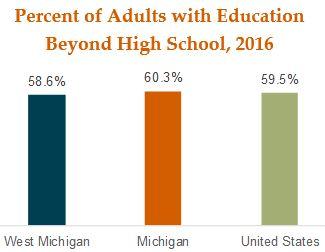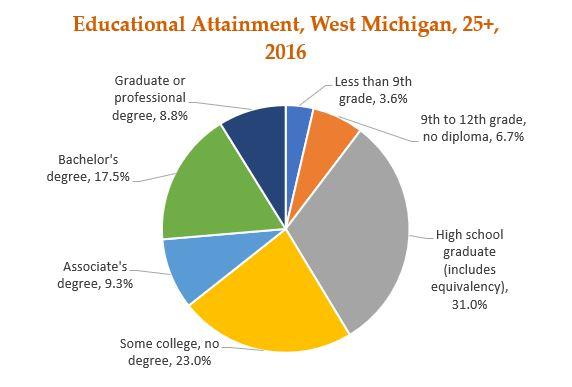The educational attainment of the adult population (ages 25+) within a region serves as a leading indicator of the strength of the corresponding labor market. As jobs become more advanced and integrated with technology, the skills necessary for maintaining employment become more specialized. According to estimates from the W.E. Upjohn Institute, 64 percent of the adult population in West Michigan will need some education beyond a high school diploma in order to satisfy the demands of the region by the year 2025.
Educational Attainment
Talent 2025’s foundational goal is that 64 percent of the adult population in West Michigan will have some form of post-secondary education by 2025, which includes certificates, Associate’s and Bachelor’s degrees, and beyond. In 2016, just 58.6 percent of the 25 and over population in West Michigan had some form of education beyond high school. While this represents a growth of 0.3 percent from the previous year, the growth rates for both the state and the nation were double that observed for the region over the same period, and West Michigan is still some 5.4 percentage points shy of our goal.

With respect to this indicator, West Michigan currently trails the statewide average by nearly 1.7 percent (inclusive of West Michigan, the state is at 60.3 percent) as well as the country, where 59.5 percent of the adult population has some education beyond high school. More specifically, 26.3 percent of adults in West Michigan have a Bachelor’s, graduate, or professional degree, slightly below the Michigan rate of 27.4 percent. However, both of these levels trail the national postsecondary attainment rate of 30.3 percent.

The Impact of Low Educational Attainment Rates
The lack of a basic education and employability skills has adverse economic and social effects for the affected population. Lacking the basic education provided through completing a high school curriculum significantly restricts their abilities to find employment, and to navigate the healthcare, education, and social welfare systems. These restrictions contribute to increased stress in the household, while serving to diminish the academic performance of their children and preventing these individuals from progressing into more advanced education and training programs. The lack of post-secondary education and credentialing among working-age adults is a significant factor in the difficulty employers find in hiring the skilled labor force they need to provide products and services to their customers, which is straining business growth and the region’s economic performance. In West Michigan, 24 percent of job vacancies are considered “hard to fill,” having been listed for 90 days or longer. Many of these jobs are in high-demand, skilled fields such as IT, health care, and advanced manufacturing. While high-demand and hard-to-fill jobs are often an entry into sustainable career paths, there are currently not enough adults in West Michigan with the credentials required by these fields.
Future Data Topics
Have you been enjoying these “Data Points” blogs? Are you interested in other data? Let us know what topics you’d like to know more about on our Twitter @WMTalent2025! We’d like to crunch some numbers that you’re interested in.


